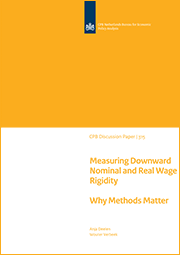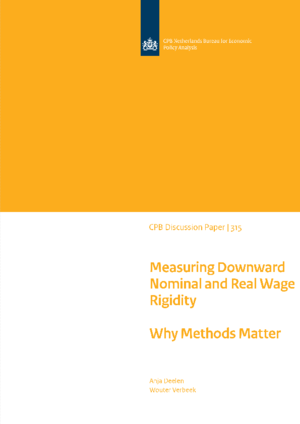Measuring Downward Nominal and Real Wage Rigidity - Why Methods Matter

The simple approach as developed by the International Wage Flexibility Project (IWFP), the model based IWFP approach and the Maximum Likelihood approach. We estimate the three models on administrative panel data at the individual level for the Netherlands (2006-2012). One main nding is that assumptions regarding the 'notional' wage change distribution (which would prevail in the absence of wage rigidity) are an important determinant of the level of wage rigidity measured. We conclude that the model-based IWFP approach is the preferred model of the three, for it has the most sophisticated method to address measurement error and the assumptions regarding the wage change distribution that would prevail in absence of wage rigidity are most plausible.
Furthermore we have researched the correlation between wage rigidity and worker and rm characteristics. Although the methods do not agree on the amount of rigidity, they agree for a large part on what variables have a positive or negative relation with downward nominal or real wage rigidity. We nd that the presence of wage rigidity is unevenly distributed among groups of workers: downward nominal and real wage rigidity in the Netherlands are positively related to a higher age, higher education, open-end contracts, full-time contracts and to working in a rm that experiences zero or positive employment growth. The consistency in the ndings regarding the determinants of wage rigidity indicate that all three methods measure the same phenomenon, which implies that estimates of determinants of wage rigidity can be compared over countries using any of the three methods. However, for measuring the fraction of workers covered by downward nominal or real wage rigidity, the choice of the method matters.
Besides, we contribute to the literature by providing accurate, internationally comparable estimates of wage rigidity in the Netherlands. The overall picture is that the Netherlands has a less than average amount of downward nominal wage rigidity but and an above average level of downward real wage rigidity, compared internationally.
Downloads
Authors

